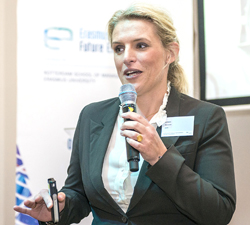E-mobility is a big part of being future-proof
Kerstin Meerwaldt is responsible for the Electric Mobility Framework Strategy at BMW Group. She introduced BMW’s perspectives, concepts and solutions to electric mobility, including features such as eco route calculations and electric charging stations with a video.
“BMW recognises we’re in times of big change,” she said. “We believe we’re in something called iconic change. There’s a co-existence in evolution and revolution,” she explained, showing that the evolution curve is becoming flatter and flatter, but the revolution curve is changing faster.
“BMW recognised the shortage of resources and higher CO2 emissions,” said Meerwaldt, explaining that demand from customers started the company thinking about finding more sustainable solutions for electronic mobility, and ‘Project i’ was born in 2007. The Dow Jones index has ranked the BMW Group as the world‘s most sustainable premium automobile manufacturer every year since 2005.
Meerwaldt said that BMW did extensive research and tested e-mobility by installing batteries in 600 minis worldwide. BMW also explored the importance of renewable energy, how often the cars should be recharged, and the length of the average commute.
 It turns out that an average commute is only 40 kilometres – well within reach of the electronic car’s rechargeable capacity, ‘so there no reason not to be more sustainable,’ said Meerwaldt. The car’s range is 90-150 km, so it needs recharging only three times per week. She added that research shows 85 per cent of charging will be at home or work, and only 15 per cent at shopping centres or other public areas.
It turns out that an average commute is only 40 kilometres – well within reach of the electronic car’s rechargeable capacity, ‘so there no reason not to be more sustainable,’ said Meerwaldt. The car’s range is 90-150 km, so it needs recharging only three times per week. She added that research shows 85 per cent of charging will be at home or work, and only 15 per cent at shopping centres or other public areas.
Green sourcing for manufacture
Renewable energy and sustainability play a vital role along the entire value chain of the BMW i3 and i8, as the sourcing also has to be green, said Meerwaldt. She added that production in Leipzig of the BMW i3 which is coming in October 2013, is powered entirely four wind turbine and collected wind is sufficient for the factory’s three production cycles. The BMW i3 is a battery electric vehicle, built of carbon fibre, which is 50 per cent lighter than steel and 30 per cent lighter than aluminium. It also has outstanding suspension qualities and resists corrosion, acids and solvents. The site where the carbon fibre in the USA is produced is next to a hydroelectric power station.
Meerwaldt said that BMW’s e-mobility solution is ‘360º electric’. “It’s all about flexible mobility and public charging,” she said, adding: “Electric mobility does exist; it will be here this year. You can have it in your everyday life.”
According to Meerwaldt, being sustainable is all about the consumer’s behaviour, not government regulations. She said the charging infrastructure, renewable home energy, energy management and storage, and sustainable concepts for second use of batteries are all interconnected.
“We need to be competent with the technology … and we need to think about the future,” said Meerwaldt. “E-mobility is a big part of being future-proof.”

